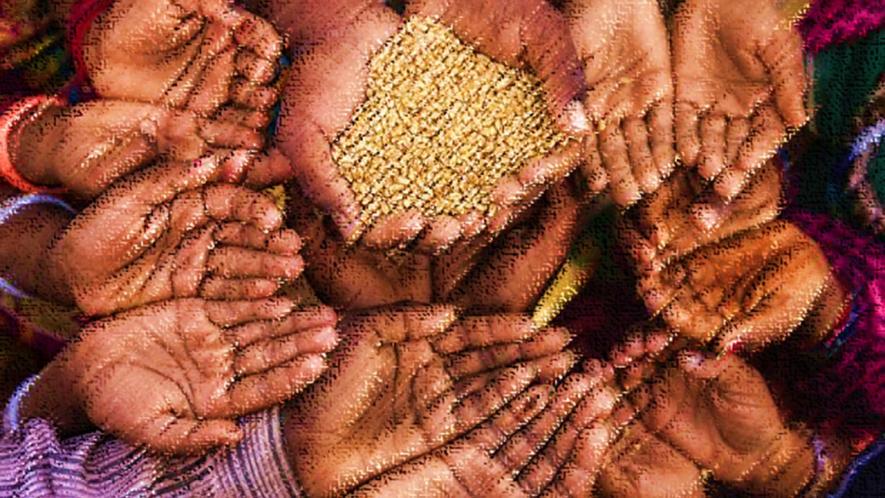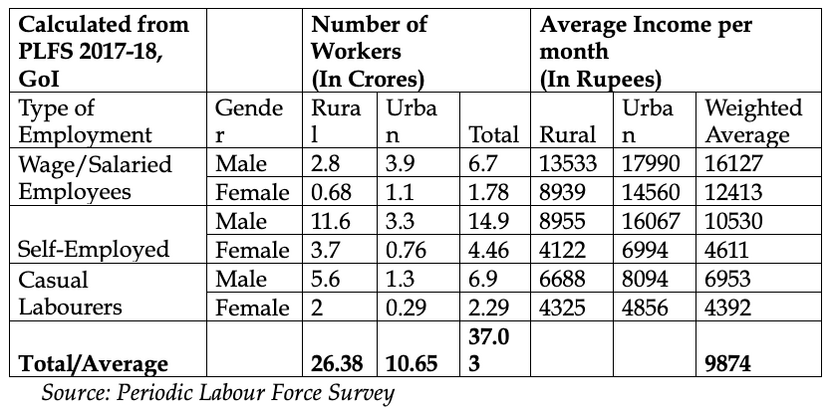Coronavirus Lockdown Could Lead to Famine, Possibly Worse

Representational image. | Image Courtesy: Telegraph
It is definitely easier for those whose income is not dependent on moving out, to stay put at home. Most casual labourers, those that are self-employed and daily-wage earners would not be able to self-quarantine themselves for long, since they will not earn if they do not venture out to work. They may still try for a week or ten days, but, if they do not get to work for between 15 days to a month, many of them would simply die of hunger. There could be food riots in the days to come, unless the government does something on an immediate basis.
According to the Periodic Labour Force Survey of 2017-18, the total estimated size of the workforce in India in 2017-18 was 37.2 crore. About 22.8% of them are salaried employees, 24.9% are casual labourers while the rest at 52.2% are self-employed. The numbers come to 8.5 crore regular employees, 9.3 crore casual labourers with the remaining 19.4 crore people being self-employed.
There are 11.6 crore rural males in the self-employed category and 3.7 crore females, with average monthly earnings of Rs 8,955 and Rs 4,122, respectively. In urban areas, there are 3.3 crore males and 0.76 crore females who are self-employed, with an average monthly income of Rs 16,067 and Rs 6,994, respectively.
In the salaried segment, there 2.8 crore rural males as against 0.68 crore rural females. Again, in urban areas, 3.9 crore are male and 1.1 crore are female. Their average wages are Rs17,990 and Rs14,560 respectively for urban males and females, and Rs13,533 and Rs8,939, respectively, for rural males and females.
As far as casual labourers are concerned, there are around 5.6 crore males and 2 crore female workers in rural areas, and 1.3 crore males and 29 lakh females in urban areas. The per day average wage rate for rural male workers was Rs 268, and that for the female was Rs173. While for urban males, the daily wage was Rs 324 and for urban female casual labourers, the number was Rs194 per day.
Even if we assume 25 workdays in a month for which they get work, the average monthly incomes of rural males and females would not exceed Rs 6,688 and Rs 4,325, respectively, while in urban areas, the figure would be Rs8,094 for males and Rs 4,856 for females.
Therefore, the common people of India earn less than Rs10,000 per month (see table below), on an average, as per the PLFS 2017-18.

Since worker population ratio is around 1::3 in India, in per capita terms, the average monthly income would be Rs3,300 or Rs 110 per day per head. Obviously, some of us earn much higher than Rs3,300 per head per month. But, there is huge inequality in income distribution.
In India, less than 3% people come under the direct tax bracket. Even if we include the agricultural rich, complete direct tax evaders etc., and if the average family size is assumed to be 4.2 members – or even if we assume there is only one earning member in each family – the direct tax payee population would not exceed 15% of the total population in India (who earn more than Rs20,000 per month, per family). Therefore, at least 85% of India’s population is practically poor. Their average per family monthly income would be below Rs 10,000 for a fact. Most of them are either self-employed or casual labourers and daily-wage earners.
Clearly, more than half of the Indian population would not be able to stay at home for long. If the Government really wants to control the spread of coronavirus by enforcing self-quarantine, it has to transfer money to this vulnerable section of population to compensate for their income loss. This is not a joke – it means providing Rs 10,000 to 30 crore casual labourers and self-employed people in a month. The total amount would come to around Rs 3 lakh crore or 1.5% of our current GDP.
This extra money is still possible to spend if the Centre has political will. Another problem which is more crucial is that of the implementation of such a huge cash-transfer scheme to as many as 30 crore workers, within a month’s time. In my mind, the easiest way to do this is to implement this through the MGNREGS vehicle. The government should extend the scheme to urban areas as well, get job cards made and increase the average wage rate from Rs 180 to at least Rs 350 per day.
The rural and urban local-bodies could ask them to demand for jobs through their mobile phones and pay them compensation instead of providing them with work. This provision is already there in the Act – sufficient money should be sent to the local-bodies quickly. This is a core centrally sponsored scheme with 90% expenditure responsibility of the Central Government. The states would surely not mind paying 10% of extra expenditures through compensation for such a scheme in this emergency-like situation.
Without making provisions for compensation in cases of income loss for the vast majority of the population, forcefully asking them to sit at home and minimising their employment opportunities would lead to a famine-like situation in an underdeveloped country like India where a majority of the workforce just earn subsistence wage without any social safety-net. If a large section of the workforce does not get any income for one month or so, there would be food riots in the country. It is high time that the government plans against it.
The writer is assistant professor, Centre for Economic Studies and Planning, Jawaharlal Nehru University, Delhi. The views are personal.
Get the latest reports & analysis with people's perspective on Protests, movements & deep analytical videos, discussions of the current affairs in your Telegram app. Subscribe to NewsClick's Telegram channel & get Real-Time updates on stories, as they get published on our website.
























